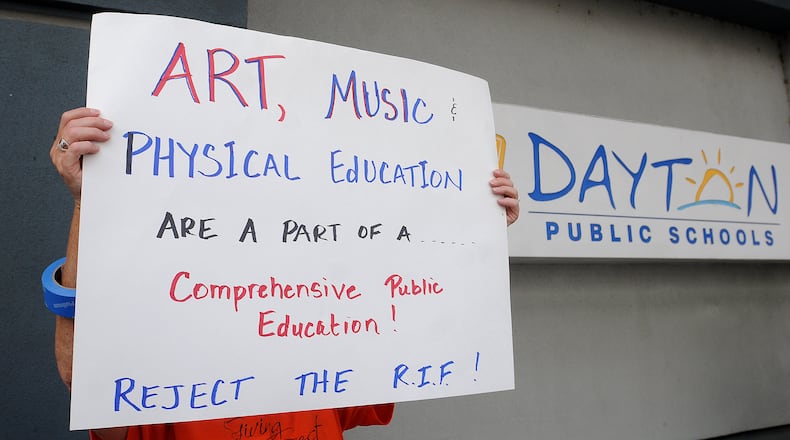The moves take effect Sept. 8-14.
On the financial side, Dayton Public Schools had a general fund cash balance of $110 million on July 31, according to Treasurer Hiwot Abraha. That’s the equivalent of 35-40% percent of a year’s spending. A Dayton Daily News examination of budgets found among other large local school districts, Springfield is similar, with about 40% of a year’s spending in the bank. But those numbers are above average, as Middletown has about 23%, Centerville 20%, Beavercreek 17% and Kettering 16% of a year’s expenses in cash reserve.
Abraha and DPS school board vice president Jocelyn Rhynard had slightly different approaches to district finances Friday. Rhynard said DPS’ financial picture “has changed pretty drastically in the past couple months.”
“Typically the five-year forecast looks fairly healthy for the first couple number of years,” Rhynard said. “There’s always a little bit of things that are up in the air by Year 5. But things have really changed and now things look very different and very bleak after Year 2.”
There was no discussion at Friday’s school board meeting of how much money the layoffs will save the district this fall. Abraha did not immediately answer that question when it was presented Monday.
But when Rhynard asked Abraha on Friday to remind people “what our fiscal outlook is at this point, and why this is a necessary step,” Abraha first said, “Financially, we are OK at this time.”
Abraha did acknowledge that the district’s long-term financial projection is downward. DPS increased general fund spending from $252 million in 2018-19 to $277 million this past year, and projects another 11% jump to $307 million this year, despite no increase in enrollment during that time.
The majority of the increase is in personnel costs, as DPS fills vacant positions and raises salaries to compete with surrounding districts.
The district is also guessing it will see a 10% cut in state funding this school year (a $17 million loss) once the state figures out its budget in the wake of the COVID-19 shutdown.
Despite that, Abraha said the cuts were not being made just out of financial need.
“Like Dr. Lolli said, if we don’t have work for those people, we cannot pay them,” Abraha said. “It’s not fiscally responsible to pay someone without giving work. It’s not because we don’t have money only.”
That led to the other side of the discussion — whether DPS should lay off certain teachers and others because a remote-learning environment didn’t fit the subjects they taught.
The board approved laying off 20 music teachers, 19 art teachers, 16 preschool teachers and 14 physical education teachers, plus 22 school nurses.
Superintendent Elizabeth Lolli offered two education-related reasons for those teacher layoffs. She said the art, music, preschool and phys ed layoffs were done because teaching those subjects in an online format doesn’t work as well. And she said since students have been out of school for more than five months, it’s crucial to get them caught up on their core academic subjects.
School board member Dion Sampson, who voted against the layoffs, questioned why the schools couldn’t still provide instruction in art, music and physical education, calling those subjects a “brain break” from constant English and math work. He said his daughters get an art supply bag weekly through Girl Scouts and get together virtually with 15 other scouts and two group leaders to produce and share artwork.
“The reality for some of our families and some of our students is if I don’t have this outlet that I really love … this outlet is what motivates me to focus on math or science,” Sampson said. “I’ll do good in math because I get to play music.”
School board member Will Smith, who also voted against the cuts, suggested with many students living in food deserts and eating unhealthy diets could benefit from physical education continuing.
Lolli said two physical education videos created by district staff will be available to elementary students each week, and each school serving students in grades 7-12 still has a health teacher. The district is also delivering lunch and breakfast meals that meet nutritional standards to students whose families sign up by 5 p.m. Wednesday.
Lolli said nurses were laid off because there are no students in schools for them to work with. Some school employees expressed concerns that those nurses might find other jobs, leaving the school district short-staffed when students eventually do return in-person after eight months.
Scott DiMauro, president of the Ohio Education Association, the state’s largest teachers union, said recently that no other greater Dayton area school district has done significant layoffs due to online education this fall. The Berea school district near Cleveland approved furloughs of bus drivers and aides last week.
About the Author

